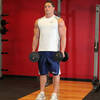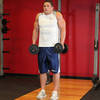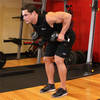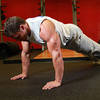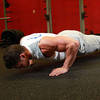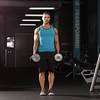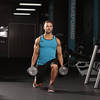Friday, September 14, 2018
MR. OLYMPIA 2018
| 2018 Mr. Olympia Qualified | |||
| Name | Country | ||
| Bonac, William | Netherlands | ||
| Curry, Brandon | USA | ||
| De Asha, Nathan | United Kingdom | ||
| Elssbiay, Mamdouh | Egypt | ||
| Griffen, Charles | USA | ||
| Heath, Phil | USA | ||
| Jackson, Dexter | USA | ||
| Kuclo, Steve | USA | ||
| Lockett, Michael | USA | ||
| McMillan, Cedric | USA | ||
| Morel, Juan | USA | ||
| Oliva Jr, Sergio | USA | ||
| Osladil, Lukas | Czech Republic | ||
| Rhoden, Shawn | USA | ||
| Rivera, Alexis | Puerto Rico | ||
| Rodriguez, Justin Luis | USA | ||
| Valliere, Iain | Canada | ||
| Wade, Josh | USA | ||
| Winklaar, Roelly | Curacao | ||
| Men's Open Point Standings | |||
| Placing | Name | Country | Points |
| 1 | Rodriguez, Justin Luis | USA | 19 |
| 2 | Wade, Josh | USA | 16 |
| 3 | Oliva Jr., Sergio | USA | 14 |
| 4 | Charles, Maxx | USA | 10 |
| 4 | Kulaev, Sergey | Russia | 10 |
| 4 | Williams, Akim | USA | 10 |
| 7 | Brandao, Rafael | Brazil | 8 |
| 8 | De La Rosa, Jon | USA | 5 |
| 8 | Yamagishi, Hidetada | Japan | 5 |
| 10 | Choopan, Hadi | Iran | 4 |
| 10 | Heirati, Sasan | United Kingdom | 4 |
| 10 | Illes, Igor | Slovakia | 4 |
| 10 | Vaillant, Antoine | Canada | 4 |
| 14 | Fritz, Roman | Germany | 3 |
| 14 | Gairy, Renaldo | Canada | 3 |
| 14 | Rowe, Brad | USA | 3 |
| 14 | Sandoe, Luke | United Kingdom | 3 |
| 18 | Budesheim, Tim | Germany | 2 |
| 18 | Muzi, Andrea | Italy | 2 |
| 18 | Raymond, Jose | USA | 2 |
| 21 | Beyeke, Lionel | France | 1 |
| 21 | Obaid, Essa | UAE | 1 |
| 21 | Romero, Manuel | Venezuela | 1 |
| 21 | Shaaban, Mohamed | Kuwait | 1 |
Tuesday, August 28, 2018
4 Reasons And 3 Ways To Spice Up Your Meals
Want to shed fat, live longer, and make your meals more exciting and
satisfying? Here's why, when mealtime rolls around, it's time to turn
up the heat.

1. Chili peppers quash hunger
When it comes to winning the battle of the bulge, the ability to tame your appetite is a powerful weapon. So, keep the hunger monster at bay by making hot sauce one of your go-to toppings.Danish scientists recently conducted a study in which they first provided subjects with a bowl of tomato soup spiked with cayenne and then, on another day, a second bowl without cayenne. The participants reported greater feelings of satiety, more sensory satisfaction, and more energy one hour after consuming the soup with cayenne than they did with the milder version.[1] The satiety-boosting effect has been attributed to capsaicin, the chemical that delivers the heat in cayenne and other kinds of chili peppers.
2. Chili peppers fire up the fat burn
Turning up the heat on your meals may stoke your fat-burning furnace. In a study by University of Arizona researchers, participants were given a supplement containing 2 milligrams of isolated capsaicin. The researchers found that participants' metabolic rate (resting energy expenditure) increased by an average of 6 percent. This caused the participants to burn an additional 122 calories per day compared to when the supplement contained a placebo.[2] As with the Danish study, these participants also reported greater feelings of satiety after taking the capsaicin supplements.
3. Chili peppers can help you live longer
Setting your mouth ablaze might be a recipe for enhanced longevity, too. According to research published in The BMJ, people who eat spicy foods such as chili peppers and chili oil 6-7 days a week enjoy a 14 percent drop in total mortality risk, compared to those who eat spicy foods less than once a week.[3] Researchers suggest that chili peppers are rich in bioactive compounds that may help in the battle against chronic ailments such as cancer and heart disease—and that people who enjoy spicy foods may also tend to follow a healthier diet overall.4. Chili peppers reduce the salt in your diet
If you're like most people, you might be consuming too much salt. If it's added taste you're after, scientists suggest that a squirt of hot sauce can make it easier to get by with a less-salty diet. Among 606 adults involved in a study published in the American Heart Association's journal, Hypertension, those who ate spicy foods tended to consume less salt overall, and had lower blood pressure numbers than those who avoided fiery foods.[4]Areas of our brains stimulated by salt and capsaicin appear to overlap. Eating foods punched up with chilies increases brain activity in both areas, tricking your brain into perceiving food as saltier than it is.
Red-Hot Recipes
With all the potential benefits of eating more chili peppers, it's a good idea to go beyond just shaking some Tabasco on your scrambled eggs. The following tasty and nutritious recipes will leave you shouting, "Fire in the hole!" Just keep some dairy products such as milk or sour cream handy to snuff out the flames.1. Mayan chocolate fudge smoothie
A touch of cayenne gives this smoothie some surprising kick, while avocado makes each mouthful deliciously thick. The drink has a winning mix of protein, carbs, and fats to help your body mend after a spirited workout.
2. Chipolata tomato jam
Chipolata peppers are smoked and dried red jalapeños. They are often packed with a flavorful tomato sauce called adobe that brings a smoky heat to recipes. This punchy chipolata-infused tomato sauce makes an exciting topping for chicken, eggs, tacos, and burgers.
3. Asparagus gazpacho
Spring's quintessential vegetable is a great stand-in for tomatoes in this version of the iconic cold Spanish soup. Blending in jalapeño adds a kick to each spoonful. Serve for lunch or dinner, and consider making the gazpacho a day or two in advance, as the flavors only get better when left lingering in the fridge. Garnish options include pumpkin seeds, feta, chopped chives, and shaved parmesan.
The Full-Body Dumbbell Workout
You Can Do Anywhere
Walk into just about any gym and you'll see guys lifting way too much weight, using too much body English and momentum, and just generally trying to impress everybody—especially themselves—with how many plates they can slap on a bar. Rodney Razor saw his share of that when he was just a kid trying to figure out what bodybuilding was all about. The more he lifts, the more he's learned to move slowly and deliberately with the appropriate weight.In his do-anywhere dumbbell workout, Razor will call out timing for the negative, and sometimes the positive, portion of the lifts. Moving slowly, he says, helps you isolate and focus on the muscles you're targeting. For all these movements (even push-ups), make Razor happy by keeping your core tight, chest up, shoulders back, and back straight.
If you're in a gym with a full dumbbell rack, you can try to dial in the weights for each individual movement, but you don't have to. The workout is designed so that you can use the same weight for all the movements. Use a weight that you can row for 12 solid reps, but that challenges you somewhere between reps 8 and 12. Sure, that's a weight you can probably deadlift a whole bunch of times, but guess what? That's exactly what you're going to do.
The workout could also be performed as a burner of a circuit, but Razor suggests doing it in straight sets to maximize the muscular overload of each move. This is minimalist bodybuilding at its best! Do it when you only have a little time, a little equipment, or a little motivation, but do it!
Walk into just about any gym and you'll see guys lifting way
too much weight, using too much body English and momentum, and just
generally trying to impress everybody—especially themselves—with how
many plates they can slap on a bar. Rodney Razor saw his share of that
when he was just a kid trying to figure out what bodybuilding was all
about. The more he lifts, the more he's learned to move slowly and
deliberately with the appropriate weight.
In his do-anywhere dumbbell workout, Razor will call out timing for the negative, and sometimes the positive, portion of the lifts. Moving slowly, he says, helps you isolate and focus on the muscles you're targeting. For all these movements (even push-ups), make Razor happy by keeping your core tight, chest up, shoulders back, and back straight.
If you're in a gym with a full dumbbell rack, you can try to dial in the weights for each individual movement, but you don't have to. The workout is designed so that you can use the same weight for all the movements. Use a weight that you can row for 12 solid reps, but that challenges you somewhere between reps 8 and 12. Sure, that's a weight you can probably deadlift a whole bunch of times, but guess what? That's exactly what you're going to do.
The workout could also be performed as a burner of a circuit, but Razor suggests doing it in straight sets to maximize the muscular overload of each move. This is minimalist bodybuilding at its best! Do it when you only have a little time, a little equipment, or a little motivation, but do it!
In his do-anywhere dumbbell workout, Razor will call out timing for the negative, and sometimes the positive, portion of the lifts. Moving slowly, he says, helps you isolate and focus on the muscles you're targeting. For all these movements (even push-ups), make Razor happy by keeping your core tight, chest up, shoulders back, and back straight.
If you're in a gym with a full dumbbell rack, you can try to dial in the weights for each individual movement, but you don't have to. The workout is designed so that you can use the same weight for all the movements. Use a weight that you can row for 12 solid reps, but that challenges you somewhere between reps 8 and 12. Sure, that's a weight you can probably deadlift a whole bunch of times, but guess what? That's exactly what you're going to do.
The workout could also be performed as a burner of a circuit, but Razor suggests doing it in straight sets to maximize the muscular overload of each move. This is minimalist bodybuilding at its best! Do it when you only have a little time, a little equipment, or a little motivation, but do it!
The Full-Body Dumbbell Workout You Can Do Anywhere
Technique Tips
Dumbbell Shrug
Start with good posture: back straight, core tight, shoulders back. As you lift up the dumbbells, squeeze your traps like you're just shrugging your shoulders. Squeeze your traps as intensely as you can, and hold the contraction for 1-2 seconds. Release slowly.Bent-Over Double Dumbbell Row
Bend your knees to get as low as you can for this exercise. Use your arms to lift the weights chest high, then take 1-2 seconds to lift the dumbbells higher by squeezing your shoulder blades together. Razor says the goal is not to see how high you can pull your elbows, it's to get that long contraction of your shoulder blades.
Squeeze your shoulder blades together, hold for a second, then take 2-4 seconds on the negative to return to the starting position. Keep your chest up, gluts tight, and back straight throughout the exercise.
Single-Leg Dead lift
Start from standing and lower the dumbbell until it's at shin level or almost touches the floor, depending on your hip mobility and hamstring flexibility. Only go as far down as you can keep your back neutral, though! At the same time, kick the unweighted foot off the ground and stretch that leg behind you as straight as possible, keeping your back straight and your chest up. When you come up, pull through your gluts and hamstrings.Once again, you'll get the most benefit from this exercise by moving slowly. Razor recommends taking 2-4 seconds both on the way up and the way down. Keep a slight bend in the knee of the weighted leg.
Push-up on Dumbbells
Push-ups on dumbbells may seem more or less the same as push-ups on the floor, but they're not. For one, the weights give you an extra couple of inches of range of motion at minimum—if you choose to use it, that is. That means you can really increase the stretch at the bottom position, and utilize more chest than floor push-ups. Being able to use a neutral grip on dumbbell handles is also a bit more shoulder-friendly for most lifters, potentially allowing them to bust out a few more reps with good form.You can position your hands and the dumbbells at whatever position you prefer, changing these positions with every set or workout. To make the exercise more challenging, elevate your feet on a bench or higher. The higher your feet are, the more you'll work your upper chest. Keep your core tight and your elbows in.
Dumbbell Jump Squat
Now things are going to get sweaty.Hold a single dumbbell with both hands at chest height, as you would for a goblet squat. Bend your knees at least until your thighs are parallel with the floor or slightly lower. As you lower your body, keep your chest up and your shoulders back. Explode into the air, keeping the dumbbell in the same position relative to your body. When you land, Razor says, use your toes, your knees, and then your legs to absorb the impact and move immediately back into the squatting position. If you've done your landing right, it should barely make a sound.
No need to count reps here; just watch or listen to the clock. Even with a light weight, your quads and lungs should be burning after a couple of 30-second sets.
Dumbbell Walking Lunge
You know Razor's drill by now: chest up, shoulders back, core tight. Holding the dumbbells by your side, take an exaggerated step forward, drive though the heel of your front foot, and lower your knee as close to the floor as you can. As you bend your forward leg, protect your knee by stopping before it goes past the toes of that foot.Find a controlled pace, and start stepping! After 30 seconds, you may be feeling fine, but after 4 rounds of 30 seconds, you should be cooked—and you should have a new respect for those bells.
Tariq grabs silver at world championship

Despite the current Mr Pakistan losing his gold medal to India’s Bobby Singh in the 80kg event, Pakistan Bodybuilding Federation (PBBF) President Sheikh Farooq Iqbal is satisfied with the bodybuilder’s performance.
“There was tough competition but the results are good,” Iqbal told The Express Tribune from Thailand. “Tariq’s efforts have really paid off. He is in excellent form and hopefully he will continue to make us proud in the future as well.”
Bodybuilding: Pakistan squad leaves for Thailand
He further added, “Pakistan had won a silver medal last year after seven years and that was a breakthrough; now Tariq has carried on this year. The important thing for us was to have a place among the top four because the competition is very fierce, especially from India.”
Iqbal believes that Tariq, despite not winning gold, has a bright future. “We were hoping for him to clinch gold but this was his first appearance at a world championship. He certainly has proven himself as one of the leading bodybuilders in his weight category.”
In other weight categories, Fida Hussain (85kg), Zeeshan Baloch (75kg) and Mujahid Hussain (55kg) all finished among the top four in their respective categories.
6 ways to train through injuries
Meanwhile Tariq’s teammate, Muhammad Furqan Khan, who could not travel with the national squad as he was suffering from dengue, believes Tariq’s feat would motivate other bodybuilders to do well.
“I’m happy for Tariq. He has begun to get his name out there and I’m sure he will make it big in years to come. His performance will certainly motivate other bodybuilders to hit the gym and improve on their fitness,” he said.
Sunday, August 19, 2018
31 Arnold-Approved Training Tips
Long before he was paid $25 million for his movie roles, Arnold Schwarzenegger penned monthly articles for bodybuilding godfather Joe Weider's muscle magazines. Arnold's writing didn't win any journalism awards, but he later collected his ideas and training philosophies in his best-selling "The New Encyclopedia of Bodybuilding," which is still used as a reference tool by bodybuilders today.
Perusing Arnold's signature tome requires some effort: The hardback version comes in at an even 800 pages, after all! While it's hefty weight might make it a nice addition to your coffee table, the nuggets of training gold take a little work to find. In the interest of mining the best knowledge from one of the strongest minds in bodybuilding, here are 31 Arnold-approved training tips to help you build your best body ever!
GENERAL TRAINING TIPS
1- CHOOSE THE BEST EXERCISES FOR GROWTH
For the Oak, training hard was as important as training smart. "To get big, you have to get strong," he wrote. "Beginning and intermediate bodybuilders shouldn't be as concerned with refinement as with growth."
With this in mind, focus less on single-joint movements (sometimes called isolation exercises) in favor of multijoint ones. The bench press, squat, deadlift, overhead press, bent-over row, and power clean are examples of solid multijoint exercises that require several muscle groups to work in coordination. These exercises should form the foundation of your training plan.
While these movements are more difficult to master than their single-joint counterparts, they offer the added benefit of allowing you to train very heavy to overload the target muscle groups. Arnold believed that performing these moves and challenging yourself with heavy weights was the single most critical component of gaining strength and size
.
2- USE HEAVY WEIGHTS FOR LOW REPS
For Arnold, choosing the right load was just as important as selecting the right exercise. After all, 8 reps of squats with 365 pounds taken to failure elicits a far better muscle-building stimulus than a set of 95 pounds for 40 reps.
"Start with a few warm-ups [not taken to muscle failure] and pyramid the weight up from one set to the next, decreasing the reps and going to failure," Arnold wrote. "Usually, I'll have someone stand by to give me just a little bit of help past a sticking point or cheat the weight up just a little [once I've reached muscle failure]."
Arnold wasn't just concerned with feeling the weight; he wanted to make sure the load induced muscle failure at a target range: "I make a point of never doing fewer than six repetitions per set with most movements," he notes," and nothing higher than 12. The rule applies to most body parts, including calves." Make sure to choose the right weight to fail within that rep range.
3- DON'T GET COMFORTABLE WITH A ROUTINE
Few people know that Arnold has a business degree, but he didn't need his diploma to realize that diminishing returns applies to workouts, too.
Do the same workout for too long without making significant changes, and its value will fall over time. That's when a bodybuilder finds himself in a training rut.
"Within a basic framework, I was constantly changing my exercises," Arnold wrote. "I liked to shock the muscles by not letting them get complacent in a constant routine."
Arnold did his homework when it came to planning his training sessions. If he found that an exercise was no longer producing gains, he'd switch it for another.
Never afraid to experiment with new exercises or alternative training methods, Arnold was on a perpetual search for new ways to become bigger and better as old ways became stale.
4- GO PAST FAILURE WITH ADVANCED TECHNIQUES
In his book, Arnold identified the use of a number of advanced training techniques as a weapon to bring up a lagging body part. Arnold used just about every intensity booster in the book, so to speak, but he zeroed in on what worked best for him simply through trial and error.
Don't be afraid to apply such techniques as forced reps, negatives, dropsets, partials, rest-pause, or other ideas you may read about to your own training. Be sure to evaluate how you feel after using one, and remember not to take every set past muscle failure; save it for your 1-2 heaviest sets of each exercise.
5- GUARD AGAINST OVERTRAINING
In your zeal to bring up a stubborn muscle group, you might be tempted to employ the "throw everything at 'em but the kitchen sink" approach, but Arnold warned that this strategy might be counterproductive. "There will be times when a body part lags behind because you are overtraining it, hitting it so hard, so often, and so intensely that it never has a chance to rest, recuperate, and grow," he wrote.
"The answer to this problem is simply to give the muscles involved a chance to rest and recover, and then to adjust your training schedule so that you don't overtrain [the same body part] again. Remember, too much can be as bad as too little when it comes to bodybuilding training."
SHOULDERS
6- OVERHEAD PRESSES ARE YOUR BEST MASS BUILDERMultijoint movements like presses and upright rows are the best mass builders for shoulders, since they engage the greatest degree of deltoid musculature. Arnold would go heavy with these movements, especially early in his workouts when his energy levels were highest. He commonly did presses both behind and in front of his head for complete development.
7- LEARN MULTIPLE WAYS TO DO THE SAME MOVEMENT
Small differences in how similar movements are done work the target musculature in slightly different ways, allowing for greater overall stimulus.
Arnold sought out alternative exercises that worked a target muscle from slightly different angles. When using dumbbells rather than the barbell on overhead presses, for example, he deliberately lowered the weights several inches below the bottom position of the barbell movement, and he brought them together at the top to elongate the range of motion.
8- ATTACK EACH DELT HEAD WITH A SINGLE-JOINT MOVE
Arnold used single-joint movements to complement overhead presses and isolate each delt head individually. Here, too, he sought subtle differences that would, over time, build better overall size. For example, the cable lateral raise in front of the body has a slightly different feel than when the cable runs behind you. Knowing how to do a given movement pattern on different pieces of equipment is, according to Arnold, essential for a bodybuilder to take his physique to the next level.
9- TRAIN UPPER TRAPS WITH DELTS
Because the upper traps get some degree of stimulation during many shoulder exercises, Arnold trained them with delts. His main upper-trap exercise was the shrug, though he noted that maximizing the size of this muscle required a number of other movements, including power pulls, cleans, and upright rows. Because the range of motion in a shrug is fairly short, Arnold recommended backing off on the weight in favor of being able to fully shrug your shoulders as high as possible.
BICEPS
10- BUILD MASS WITH THE STANDING BARBELL CURLArnold loved the standing barbell curl for building baseball biceps. When looking for a major mass-building move, Arnold preferred exercises that allowed him to push heavy weight, let him achieve a full range of motion, and could be hammered for 6-8 heavy reps. That's how he built his biceps into mountains, and it's a great start for your workout, too.
11- DON'T STOP AT FAILURE
While the Oak commonly took his curls to muscle failure, he didn't stop there. Once he reached a sticking point, he'd use just enough momentum to keep the set going. Such cheat curls allowed him to complete an extra couple of reps, helping to further stimulate the muscle.
12- SUPINATE YOUR DUMBBELL CURLS
Arnold wrote that he always included at least one dumbbell movement in his routine. By supinating his hand (turning it upward as he curled), he felt he got a greater "peaking" effect because the brachialis is recruited into the motion when the hand starts in the neutral position. Arnold performed supinating dumbbell curls simultaneously and with alternating reps. The latter allows more body English and a bit of rest between reps.
13- USE HIGHER REPS ON CERTAIN EXERCISES
Not every biceps movement was done for 6-8 reps. Arnold identified certain exercises that he called "definition-building movements," which he performed with relatively lighter weights for sets of 8-12 reps. Here, his focus was on squeezing and contracting the muscle, and holding the peak contraction for a long count. Concentration curls, preacher curls, and alternating dumbbell curls were among his favorites.
TRICEPS
14- EXPERIMENT WITH A STRONG BODY PARTArnold's chest and triceps were particularly strong body parts, so he didn't train them in the same ways he did his biceps. Because his triceps were already strong, Arnold allowed his rep range to drift up to 20 per set in an effort to hyperpump the muscle.
15- FIND THE TARGET OF AN EXERCISE
"It's silly doing a triceps movement and not knowing precisely which part of the triceps you're hitting," Arnold wrote. Great advice, but how should you apply it?
Arnold suggested a tip he learned from legendary trainer Vince Gironda: Do 20 sets of a particular movement, and then nothing else for that body part.
See where the soreness is most concentrated the following day.
16- ADD PARTIALS AFTER FAILURE
With triceps, Arnold's advanced technique of choice was partial reps. After doing a set of full-range push-downs, for example, he'd extend the set with 5-6 partials, either over the top or bottom half of the movement.
Even though he couldn't do any more full-range reps and was limited by the sticking point, he could still manage a few more reps to really spur growth.
17- DO SUPER SETS TO INTENSIFY THE PUMP
Arnold frequently superseded biceps and triceps movements—or, in other words, performed exercises back to back—to bring an enormous amount of blood into his arms. Blood carries oxygen and nutrients critical for growth, but these super sets also enabled Arnold to achieve his ultimate training goal: a killer pump. Super setting a smaller muscle group like arms is easier than a larger one like legs, though Arnold often did that pre-contest as well.
LEGS
18- PRIORITIZE YOUR WEAKNESSESIf you've got big pecs, it's only natural to want to show them off, and you probably also give them a little extra effort in the gym. But Arnold took exactly the opposite approach. In fact, at one point, Arnold decided his calves had fallen behind the rest of his physique in overall development.
Rather than hide the glaring weakness, he famously cut off the lower half of his pants and wore shorts to constantly remind himself of his weakness and redouble his efforts to bring them up. He trained calves more frequently, early in his workouts when he was fresh, and sometimes between sets for larger body parts, a strategy that helped him claim the world's biggest bodybuilding title.
19- TEST EVERYTHING
Being long-legged, calves weren't Arnold's only shortcomings early in his career; his thighs were also comparatively small. That meant throwing out the usual playbook on leg day. "Building up legs was hard for me because I have long legs and long leg muscles," he wrote.
"The long-legged bodybuilder has to explore a wider variety of exercises in his lower-body routine. That means incorporating other exercises until you find out which ones make your legs respond best. And you have to keep varying your routine so that your muscles are constantly surprised by the demands you're putting on them."
20- ADJUST YOUR STANCE AS NEEDED
When squatting, Arnold found that different foot positions worked different areas of the thighs. "With my feet farther apart and toes pointed out, I feel squats on the insides of my thighs," he wrote. "The position of the feet largely determines which part of the thigh is most affected."
Arnold liked to use various squats and squat machines, both standing and lying, so he could to use various foot placements and target every part of his legs.
21- USE MACHINE SQUATS TO YOUR ADVANTAGE
Machine squats may not be superior to free-weight ones, but Arnold goosed them to make them harder. Here, Arnold used a shortened range of motion—going about three-fourths of the way down to a quarter of the way from the top, a technique he called "tension squats"—which allowed him to induce an incredible burn without having to balance the weight.
22- ADD HAMSTRING EXERCISES
While the hammies get worked during basic squat and leg-press movements, contracting to control the speed of the descent as the quads are being stretched, Arnold argued that you still need to do exercises that directly target this area.
Deadlifts are a great total-body movement, and single-joint leg curls and Romanian deadlifts also focus on the rear thighs. Hamstring strength is important to reduce the risk of knee injuries, which can occur when the strength of the quads overpowers the strength of the hams.
ABS
23- TRAIN YOUR ABS INDIRECTLYArnold's approach to ab training was fairly simple, and he had a few favorite moves that he did for fairly high reps. Then again, when you consider how hard he trained his core with his thrice-weekly leg and back workouts, you'd venture he probably didn't even need to train his abs at all.
Heavy, multijoint free-weight movements clearly played a bigger role both in the strength and aesthetics of his midsection than his limited abdominal workouts.
CHEST
24- BUILD STRENGTH TO BUILD SIZEFor Arnold, building a big chest started with training for strength since he competed as a powerlifter early in his career. With a foundation of strength, Arnold discovered that gains in size came easier. Consider an offseason powerlifting cycle to help boost all your numbers before shifting back into bodybuilding-style training. For the record, Arnold once benched 225 pounds for 60 reps!
25- USE MULTIPLE ANGLES
Arnold included basic multijoint movements in his routine that hit the pecs from a variety of angles. "I knew the routine had to be basic and very heavy," he wrote. Basic, for Arnold, meant sticking to flat, incline, and decline benches while occasionally training like a powerlifter rather than trying a multitude of machines or using trendy techniques. Arnold saved pumping sets for the end of his workout.
26- CYCLE TRAINING VOLUME TO SPUR GROWTH
What makes Arnold's routine stand out today is the volume and frequency with which he trained every body part. His offseason chest routine consisted of up to 26 working sets on a high-volume day, and he trained his pecs three times a week! Arnold also cycled heavy and light days to work the muscles with different relative intensities and ensure he wasn't overtraining his pecs.
That kind of volume and frequency suited the Oak during his competitive years, but cycling off periods of high volume or high-frequency training ensures you're less likely to overtrain.
27- GET TO KNOW DUMBBELL VARIATIONS
While Arnold favored barbells in the gym because of the heavier weights he could lift, he knew the advantages of dumbbells. "I feel a better stretch when doing dumbbells, especially with incline movements. The dumbbells can be lowered deeper than a barbell," he noted.
Dumbbells allow you to work through a longer range of motion, but be careful not to overstretch the shoulder joint at the bottom of the move.
BACK
28- VARY YOUR PULL-UPS AND PULL-DOWNSArnold typically divided his back training into two types of movements: chinning and pull-downs for width, and rows for overall thickness. With the former, he used all kinds of variations, in part because he had to bring his back up to match his pecs.
So he did underhand-grip chins and pull-ups with and without added weight, and he varied his pull-downs, sometimes bringing the bar behind his head and other times to his chest. The net result was an assault that worked the lats from multiple angles for better overall development.
29- MIND YOUR ELBOWS
"Wide-grip pull-ups coax the upper lats to come out," Arnold wrote. Understand that with wide-grip movements, the elbows stay out away from the sides, which engages the upper lats more effectively. With closer-grip and reverse-grip back exercises, the elbows stay in tighter to the sides, which reduces the emphasis on the upper lats and instead places more of the focus on the lower lats. So depending on elbow position relative to your torso, you can effectively focus on some areas of the back over others.
30- SHOOT FOR A REP TARGET
Most trainers typically do 3-4 sets of an exercise, but with chins Arnold commonly used a technique in which he aimed for a total number of reps—say, 50—rather than target a particular number of sets: "On the first set you may do 10 reps. Perhaps you struggle with 8 reps on the second set. You have 18 reps now. If you make 5 on the third set, you have 23 reps. You continue to add them until you've reached 50, even though it may take you 20 sets to do it. That's how I built up my chinning power, and I was very successful with it."
31- DO ROWS, PYRAMIDING THE WEIGHT UP
Exercises in which you pull the weight perpendicularly into your body—often called rows—were a big part of Arnold's back workout. He favored all kinds of variations—seated cables rows, T-bar rows, bent-over barbell rows—but each one was done with high volume and progressively heavier weights. Arnold followed a pyramid scheme in which he increased the weight on successive sets for fewer reps. Only the heaviest sets were taken to muscle failure.
GROW LIKE THE OAK
Armed with these 31 ironclad tips, it's your turn to train and grow like Arnold! Get to the gym, get under the bar, and be sure to hit compound exercises for some heavy weight. Oh, and if you have any favorite tips to share on your way out, drop them in the comments section below!
The 5 Rules of
Gaining Muscle Mass
Gaining Muscle Mass
(Pack on the Pounds)
We’ve compiled a list of the 5 most important nutrition rules to help you get the best gains from your workouts. Here they are in order of importance.
Whenever you start anything new, there’s always a learning curve and you’re bound to make a few rookie errors along the way. In bodybuilding there are two main mistakes beginners tend to make
Following a training program that’s not appropriate for their goals
Underestimating the importance of nutrition
You don’t grow just because you train; growth is actually dependent on proper recovery from training. And the way you recuperate best is by providing your body with the nutrients it needs at the appropriate times for optimal recovery and growth. Your goal is to add lean mass — muscle tissue. That’s true whether you’re a hardgainer, a guy with good genetics or a guy who carries excess bodyfat. Here are the basic nutritional principles you need to support your training to maximize your chances for muscle growth right out of the gate
Make sure you consume adequate calories every day
The bottom line is you can’t add weight if you aren’t taking in more calories than you’re burning. If you’re trying to pack on muscle, you have to consume enough surplus calories to support that growth. If you’re heftier to begin with, this task is a little trickier. You need to get enough calories to add muscle mass, but you also want to avoid an excessive increase in bodyfat. While you’re adding muscle mass, you should regard maintaining or just slightly increasing your bodyweight as progress
Split your total calories fairly evenly over 5–6 meals per day
This recommendation is a bodybuilding standard. The more frequently you feed your body, the better the contribution you’re making to build muscle mass while at the same time avoiding the addition of bodyfat. If you consume 3,000–4,000 calories over six meals versus just three meals, your metabolism will stay elevated and you’ll gain more muscle and much less bodyfat. Those who consume the same number of total calories, but in fewer, larger meals, however, send their bodies the signal to store bodyfat.
Take in at least 1 gram of protein per pound of bodyweight each day
When you want to build muscle tissue, you have to provide your body with the amino acids it needs. These aminos (there are 22 in total, essential, nonessential and conditionally essential) come from protein foods and protein supplements. Eating a variety of different protein sources is the best way to make sure you get a broad range of aminos. By targeting at least 1 gram of protein per pound of bodyweight, split fairly evenly over your six meals, you’ll keep a steady flow of aminos in your bloodstream to fuel growth
Eat plenty of fruits and vegetables
Many beginners focus too much on protein or calories at the expense of other types of foods that are dense in nutrients per calorie. Make sure you get in at least six servings of vegetables and fruit each day. They’re low in calories but rich in vitamins and minerals to support gains and overall health. At larger meals, you should consume more than one serving and you can do your body an even bigger favor by having a few different fruit or veggie items on your plate
Emphasize workout-window nutrition
Around the time of your workouts — before and after — your body needs protein and fast-digesting carbs (sugar) to drive the recovery process. Consuming sugar before and after your workouts helps reload glycogen burned during exercise, and it delivers amino acids to your muscles so that they recover and grow more quickly. Take in about 25–40 grams of protein before and after your workouts, depending on your bodyweight. Hardgainers should match their sugar intake to their protein consumption, gram per gram, pre- and post-workout. If you’re a bigger guy starting out, you can cut the sugar before workouts and just take it after.
Thanks with your success!
Sunday, August 12, 2018
The Meanest Mean-Ass Arm Workout Yet
If Abel Albonetti says this is the meanest workout he's ever done, you'd better be prepared for a serious smackdown. A MuscleTech-sponsored athlete and Team Bodybuilding.com member, Albonetti is known for his hardcore workouts, and this arm blast doesn't disappoint.
During a workout that had Albonetti himself groaning in pain during filming, you'll be supersetting biceps exercises with triceps exercises in a way that quickly exhausts your arms. That's too bad, because it's going to be a very long workout.
All right, campers, cinch up your shorts and let's get to it.
Technique Tips
Seated Dumbbell Curl and Skullcrusher
Albonetti starts you off with 4 straight sets of dumbbell curls. Take each rep slow and easy with lots of good, long negatives. During the concentric portion of the lift, rotate your pinkies all the way in to get full rotation at the top of the exercise.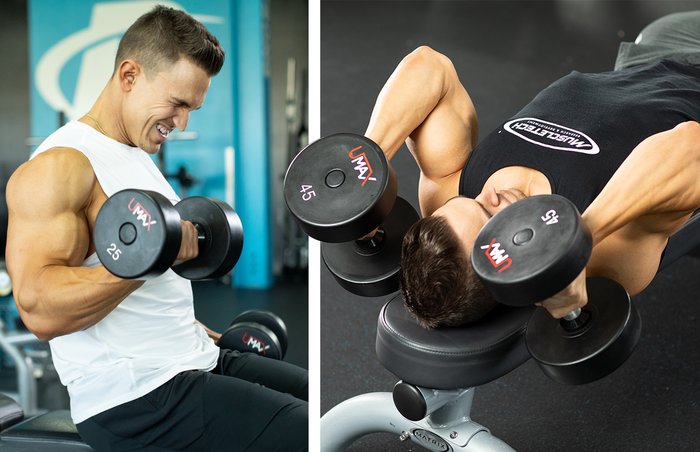
Follow the same rep plan for the skullcrushers. Hold the stretch at the bottom of the rep, keeping tension on your triceps.
Preacher Curl and Standing Dumbbell Triceps Extension
When you do the preacher curls, make sure you're not going all the way up and losing tension. Keep that bar constantly moving so your muscles are contracted the whole time. When you're doing the triceps extension, tuck in your elbows. Don't flare them out. Go all the way down to stretch out your triceps. As with the preacher curls, don't pause at the top. Keep going to maintain tension on your biceps and triceps the whole time.On the last set, Albonetti tosses in a double dropset—for both exercises. Go to failure on these. You might not be able to do as many reps as you did at first, but push for at least 6 reps.
Incline Dumbbell Curl and Cable Rope Overhead Triceps Extension
Go all the way down on the incline curls for a good biceps stretch. At the bottom, flex your triceps to stretch your biceps to the max. After you complete the twelfth rep of the fourth set, lower your arms all the way one more time and hold 30 seconds for a good stretch. Drop the weight by about 10 pounds, rep to failure, and lower the dumbbells for another 30-second stretch. Reduce the weight another 10 pounds, rep to failure, and repeat.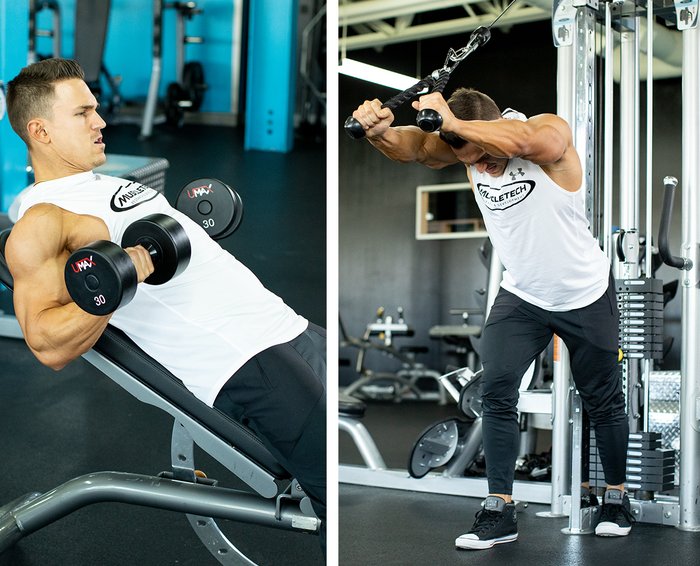
According to Albonetti, if you can do 10 reps or more before failing in either of these final sets, add more weight the next time.
Barbell Curl 21s and Triceps Push-down 21s
Do the first seven barbell curls while standing up, moving the bar up from your thighs to parallel to your waist, then immediately sit down for the next seven curls. When you're sitting, you won't be able to lower the bar past your thighs. Once you've done seven of these reps, stand up again and do the last seven reps as full reps, moving the bar from your chest to your thighs for a total of 21 reps.Stand for all the triceps push-downs. For the first seven reps, start with the rope at your waist and push down to your thighs. For the next seven, start with the rope at your shoulders and push down to your waist. For the final seven reps, do complete reps, moving the rope from your shoulders to your thighs for another total of 21 reps. On the rope push-downs, flare the rope ends as much as possible.
Hammer Curl and Cable Single-Arm Triceps Extension
Alternate your arms on the hammer curls to go as heavy as possible. When you're doing the triceps extensions, as the cable goes across your body, squeeze your triceps for a full contraction. At the bottom, squeeze your arm muscles for about half a second.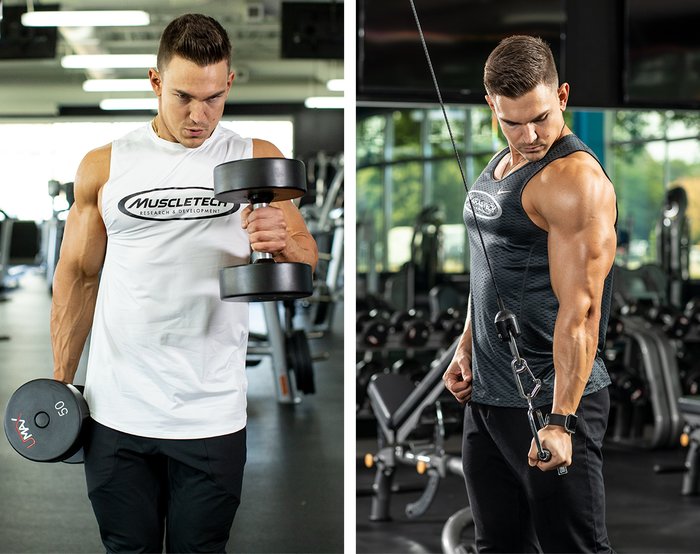
Standing Biceps Cable Curl and Triceps Push-down
What better way to finish Albonetti's mean-ass workout than to strap on a pair of BFR straps? You'll achieve a huge pump and engorge your arms with nutrients and blood.Position the BFR bands high up on your biceps. Wrap them with a tightness of 6-7 out of 10. Keep them in place for all 5 sets. As you do these BFR sets, rest 45 seconds between sets to create that extreme pump.
Albonetti recommends doing this workout once every two weeks. There's too much volume—and it's just too damn tough—to do it every week.
5 Signature Moves for a Crowded Gym
By learning these five variations on exercise mainstays, you'll
stimulate your muscles in new ways and have more choices when there's
lots of competition for equipment.
Today, Smith is known for sharing all kinds of unique movements on social media, in articles like "Julian Smith's Signature Moves for Legs," and in his Bodybuilding.com All Access program 30 Days to Your Best Arms. But he's not just changing things for the sake of changing things; on the contrary, he finds that it dials in his technique and increases the mind-muscle connection.
"When something is new and exciting, when you've never done it before, you're going to put a little more focus on your technique to make sure you're doing it the right way," Smith says.
Here are five twists on some old standby exercises that will keep your mind and gains fresh, while also helping you make the most of the limited equipment available in a busy weight room.
1. Heels-Elevated Dumbbell Goblet Squat
When there are lots of people in the weight room, the squat racks can be the first place to fill up. You have a choice: sit and wait, or look for alternatives.So, what makes his version of the goblet squat a worthy alternative to the almighty barbell front squat?
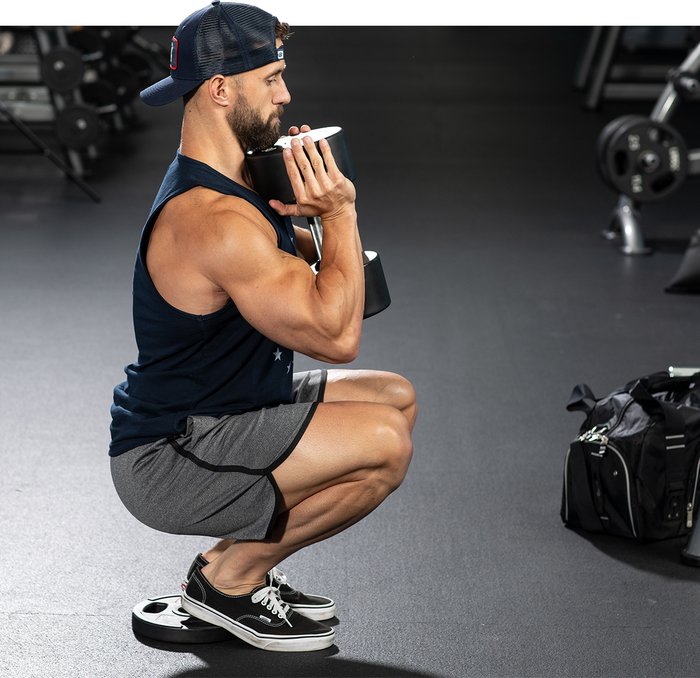
Smith addresses that situation by swapping out the barbell for a dumbbell, and upping the reps to where few people brave to go with barbell front squats.
What's more, he recommends performing this squat variation with your heels—and only your heels—touching, and elevated about the width of a plate. Point your knees out as you would in a normal squat stance. Keep the weight pressed against your chest, keep the lowering half of the rep slow, and you'll definitely feel it in your quads.
"This variation is basically a front squat because this also keeps the weight centered close to your body as it would be if you were doing a normal front barbell squat," Smith explains.
Sets and reps: 4 sets of 20, 15, 10, 10 reps
2. Good Morning Into a Squat
Good mornings and squats are both great exercises on their own. So why do them together? For one, it'll help you hit every part of your legs without having to use a heavy weight. You'll feel your hams and glutes getting stretched to the max on the good morning, and then they and your quads will power you through the squats. It'll also allow you to maximize the precious time you have in the squat rack, if you were planning on doing squats first and then a hamstring-focused movement like RDLs or stiff-legged deads afterward.A good morning is very difficult to do with a lot of weight on the bar, so you want to use 20-25 percent of your normal squat weight. You may be able to squat 315 pounds for 8 reps, but you're not going to be able to carry that much in a good morning.
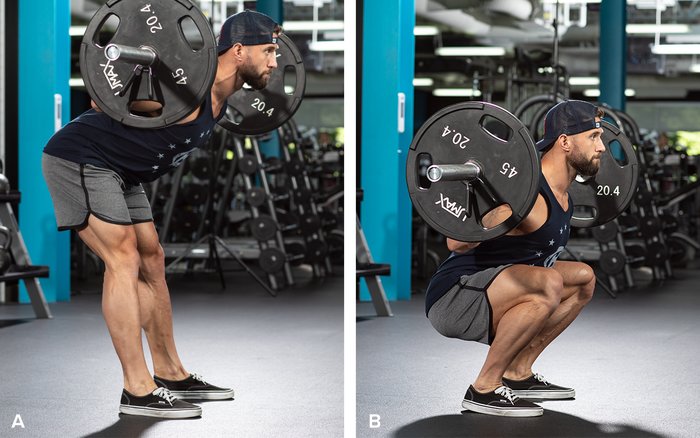
Sets and reps: 4 sets of 12, 10, 8, 8 reps
3. Seated Cable Row Wide-Grip Lat Pull-down
If you're working out in a crowded gym and the lat pull-down machines are taken, your back day doesn't have to come to a grinding halt. Just find an open seated cable row machine and do your pull-downs while lying facedown on the cable row bench.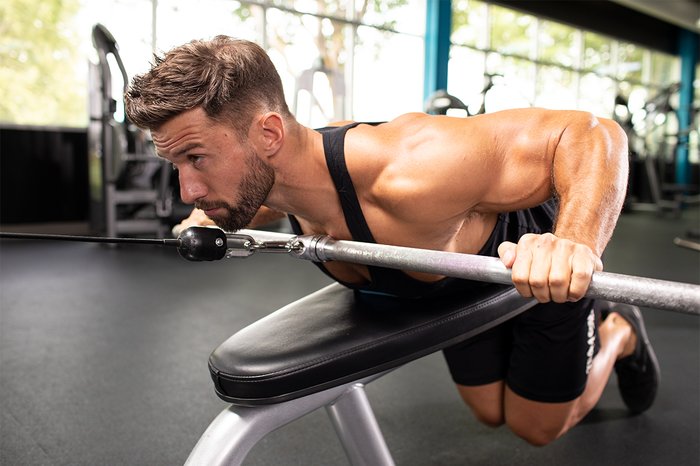
Sets and reps: 4 sets of 10 reps
4. Bodyweight Leg Extension
This is another perfect variation for a day at the gym when everyone seems to be on the same split as you."Bodyweight leg extensions are basically the exact same movement as a leg extension," Smith says, "but you can do them without a leg extension machine just by using the floor and your body weight."
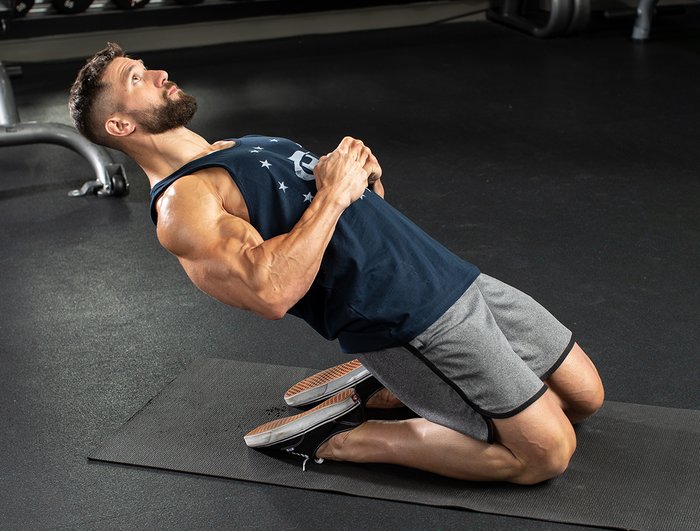
Sets and reps: 4 sets to failure
5. Wrestler's Bridge
Wrestling bridges used to be a staple of strength training, but you don't see them much anymore. But if you're simply doing shrugs in the hopes that it'll give you that "strong like a bull" look, this may be just what you need. (Keep doing those shrugs too, though.)"A lot of people think this is a pretty barbaric exercise, but it's an old-school move," says Smith. "Not a lot of people want to lie on their back and lift their entire torso off the ground by their head and neck support, but it's actually a very safe exercise. A lot of people do it for wrestling and MMA-style training."
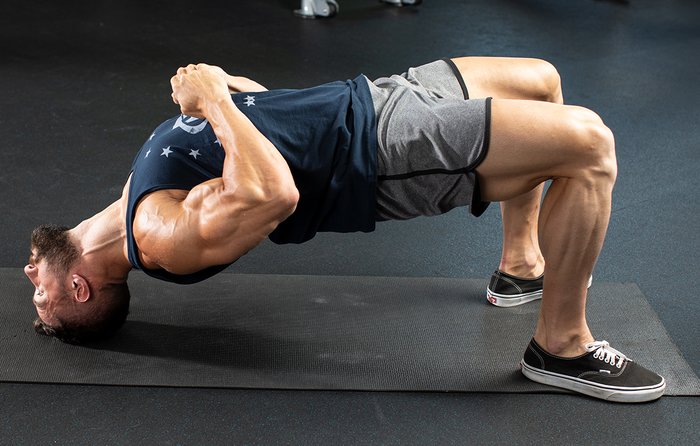
Sets and reps: 4 sets to failure
Subscribe to:
Comments (Atom)
Most Powerfull
How to get rid of muscle cramps in your legs The muscles in your legs are made up of bundles of fibers that alternately contract and ...




